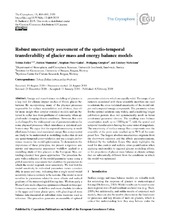| dc.contributor.author | Zolles, Tobias | |
| dc.contributor.author | Maussion, Fabien | |
| dc.contributor.author | Peter Galos, Stephan | |
| dc.contributor.author | Gurgiser, Wolfgang | |
| dc.contributor.author | Nicholson, Lindsey | |
| dc.date.accessioned | 2020-05-20T12:39:22Z | |
| dc.date.available | 2020-05-20T12:39:22Z | |
| dc.date.issued | 2019-02-08 | |
| dc.Published | Zolles T, Maussion F, Peter Galos, Gurgiser, Nicholson L. Robust uncertainty assessment of the spatio-temporal transferability of glacier mass and energy balance models. The Cryosphere. 2019;13(2):469-489 | eng |
| dc.identifier.issn | 1994-0424 | en_US |
| dc.identifier.issn | 1994-0416 | en_US |
| dc.identifier.uri | https://hdl.handle.net/1956/22316 | |
| dc.description.abstract | Energy and mass-balance modelling of glaciers is a key tool for climate impact studies of future glacier behaviour. By incorporating many of the physical processes responsible for surface accumulation and ablation, they offer more insight than simpler statistical models and are believed to suffer less from problems of stationarity when applied under changing climate conditions. However, this view is challenged by the widespread use of parameterizations for some physical processes which introduces a statistical calibration step. We argue that the reported uncertainty in modelled mass balance (and associated energy flux components) are likely to be understated in modelling studies that do not use spatio-temporal cross-validation and use a single performance measure for model optimization. To demonstrate the importance of these principles, we present a rigorous sensitivity and uncertainty assessment workflow applied to a modelling study of two glaciers in the European Alps, extending classical best guess approaches. The procedure begins with a reduction of the model parameter space using a global sensitivity assessment that identifies the parameters to which the model responds most sensitively. We find that the model sensitivity to individual parameters varies considerably in space and time, indicating that a single stated model sensitivity value is unlikely to be realistic. The model is most sensitive to parameters related to snow albedo and vertical gradients of the meteorological forcing data. We then apply a Monte Carlo multi-objective optimization based on three performance measures: model bias and mean absolute deviation in the upper and lower glacier parts, with glaciological mass balance data measured at individual stake locations used as reference. This procedure generates an ensemble of optimal parameter solutions which are equally valid. The range of parameters associated with these ensemble members are used to estimate the cross-validated uncertainty of the model output and computed energy components. The parameter values for the optimal solutions vary widely, and considering longer calibration periods does not systematically result in better constrained parameter choices. The resulting mass balance uncertainties reach up to 1300 kg m−2, with the spatial and temporal transfer errors having the same order of magnitude. The uncertainty of surface energy flux components over the ensemble at the point scale reached up to 50 % of the computed flux. The largest absolute uncertainties originate from the short-wave radiation and the albedo parameterizations, followed by the turbulent fluxes. Our study highlights the need for due caution and realistic error quantification when applying such models to regional glacier modelling efforts, or for projections of glacier mass balance in climate settings that are substantially different from the conditions in which the model was optimized. | en_US |
| dc.language.iso | eng | eng |
| dc.publisher | EGU | en_US |
| dc.rights | Attribution CC BY | eng |
| dc.rights.uri | https://creativecommons.org/licenses/by/4.0 | eng |
| dc.title | Robust uncertainty assessment of the spatio-temporal transferability of glacier mass and energy balance models | en_US |
| dc.type | Peer reviewed | |
| dc.type | Journal article | |
| dc.date.updated | 2020-02-18T11:09:27Z | |
| dc.description.version | publishedVersion | en_US |
| dc.rights.holder | Copyright 2019 The Author(s) | en_US |
| dc.identifier.doi | https://doi.org/10.5194/tc-13-469-2019 | |
| dc.identifier.cristin | 1699220 | |
| dc.source.journal | The Cryosphere | |

